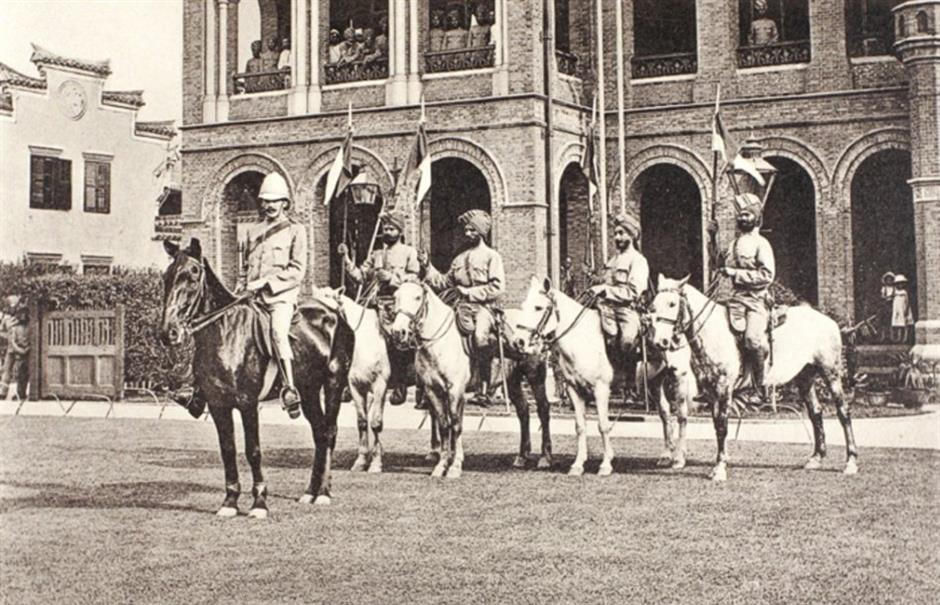Witness to police history in Shanghai
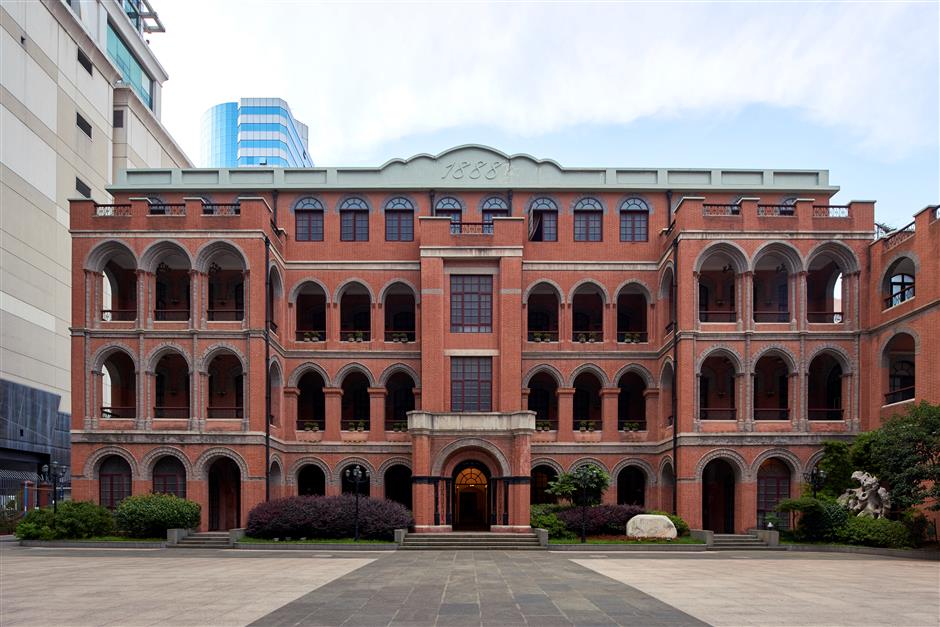
The imposing facade of the building that used to house a police station in the late 1800s
A red-brick building on the campus of Shanghai Business & Tourism School is a witness to the history of policing in old Shanghai.
Completed in 1889, the Louza Police Station on Nanjing Road was the first of the 15 branches of the then Shanghai Municipal Council’s Central Police Station, says Zhang Yaojun, a researcher from Shanghai Archives Bureau.
When founded in 1845, the former British settlement had no police officers but only Chinese nightwatchmen to look out for fires, Zhang adds. “After the Shanghai Municipal Council that managed the foreign settlements was established in 1854, the police station was formed immediately to maintain social order and public security.”
According to Zhang Bin’s book “A Study of the Police System and Its Management in the Former Shanghai British Settlement (1854-1863),” Shanghai’s police organization directly referred to the English police system which originated in the 1820s.
“During the first decade of the former British settlement, foreigners and Chinese lived separately. There were only a few foreign residents and civil affairs. After the Small Sword Society Uprising in 1853, some 20,000 Chinese refugees flooded into the settlement. The expatriates, who profited from leasing houses to the Chinese, found emerging problems when refugees drank a lot, fought and caused traffic jams. So there was an urgent need to restore social order,” Zhang wrote in the book.
That led to the immediate founding of the Shanghai Municipal Council and its police station in 1854.

An archive photo of the Louza Police Station in the 19th century
“At the beginning, the constables and policemen were neither well-educated nor professional. But when it came to the late 19th century, the local police team improved greatly after the council recruited graduates from British police schools and sent constables for training in Ireland,” researcher Zhang Yaojun says.
Louza Police Station was established to cover a central area enclosed by today’s Suzhou Creek and Yan’an, Xizang and Shaanxi roads. The project, which cost 46,000 taels of silver, kicked off on August 1, 1888 and was completed the following year. The main building, a brick-and-concrete structure, as well as a few old cells are well preserved today.
When the police station was nearing completion on December 6, 1889, the North China Herald reported that “recent visitors to Shanghai have noted with some astonishment the handsome facade of a fine red-brick building nearly hidden behind the unbeautiful Racquet Court.” The paper explained that what surprised visitors was the fact that such an imposing building, “the first really important public edifice constructed by the municipal council,” was simply a police station for the Louza district.
“The main building is mainly in the Venetian Gothic style and is of red brick with dressings of gray brick and Ningpo freestone. Unlike a good many red-brick edifices, the new police station is not finished off at the back or sides with cheap material such as common brick or plaster, but has red brick on all sides,” the report said.
According to the report, the walls were covered with gray stucco, pleasing to the eyes. The doors and balustrade were of teak and properly strong and solid. In one or two places, such as the woodwork over a doorway in the inspector’s quarters and the newels of the balustrades, there was carving highly to the credit of the Chinese artisan. A feature of the staircase was an ornamental arcade on the second floor, having three arches on brick columns with well-carved capitals.
Today, the building still looks a lot like what the 19th-century report described. Covering an area of 936 square meters, the building’s front has a commanding appearance and each of the three stories is designed with a verandah in front.
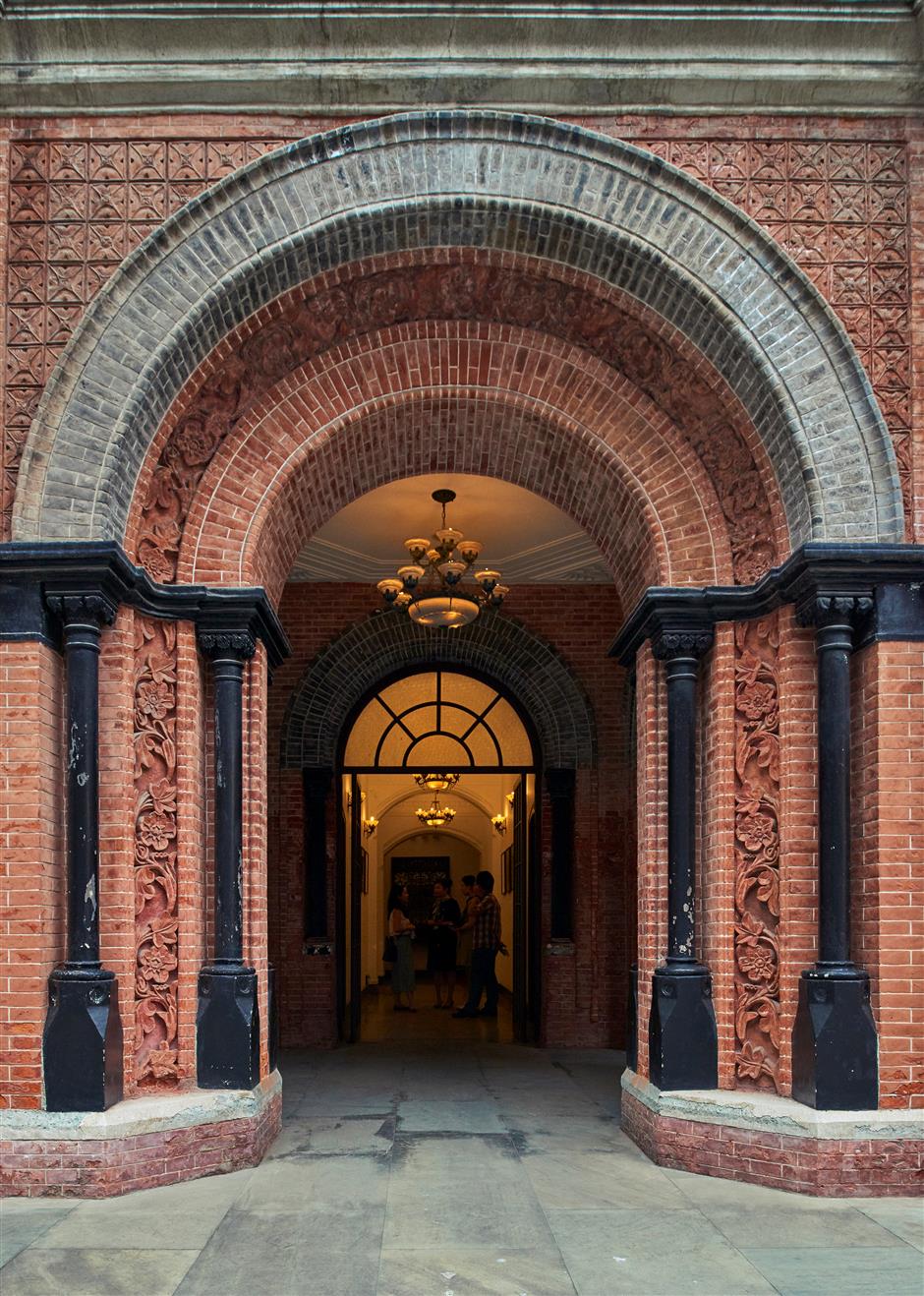
The entrance to the former police station, which now houses a mini museum with a Shanghai commerce theme
It was not only a beautiful building, but also was functional as a 19th-century police station to house staff of different nationalities.
According to the North China Herald, the ground floor housed the foreign constables’ room, a pantry, the charge room, the lost property office, the canteen, the billiard-room for foreign constables and the native constables’ room.
The first floor had been divided into two unequal parts, one wing and part of the central space being devoted to the inspector in charge and the rest of this floor to Sikhs. The inspector had a front bedroom, and in the wing a sitting room, a dining room, a bathroom, pantry and cupboard. In the Sikh section was a sergeants’ bedroom, a “joss” room, an interpreters’ room and a large bedroom for the accommodation of Sikh constables.
On the second floor, which was for the European sergeants and constables, the whole central space was devoted to a bedroom and lavatory for the use of 12 constables. In one wing was a bedroom for four sergeants with a bathroom, in the other a reading room with bathroom.
From this floor, access was gained to the tower, from the top of which a splendid view over the settlement was to be had. A lookout could communicate below with a speaking-tube. It’s a pity that the ornamented tower has been demolished.

The corridor leads to the ground floor which used to house the foreign constables' room, a pantry, the charge room and the canteen.

“The police team was rather international from today’s point of view. European sergeants and constables were in charge of management. Chinese constables were good at gathering information and managed Chinese-related cases. Sikh constables were responsible for guiding traffic while Japanese constables covered Hongkou and Putuo areas where many Japanese factories were located,” researcher Zhang says.
According to his research, the Louza Police Station was also designed to house up to 30 Chinese prisoners, 10 foreign prisoners and some 20 beggars.
As a big police station for the city’s central areas, the building witnessed many historical events, the most noteworthy being the May 30th Movement.
On the morning of May 30, 1925, Shanghai police held 15 student protesters in the Louza Police Station. A huge crowd of Chinese amassed outside demanded they be released but the police opened fire.
The shootings that killed nine and injured 14 sparked international censure and nationwide anti-foreign demonstrations and riots. The monument for the May 30th Movement now stands in the People’s Park, a few minutes’ walk from the red-brick building.
After 1949, the building became Pei Guang Middle School and since 1985 has been used by Shanghai Business & Tourism School, which is renowned for training future employees for the tourist industry including leading Chinese airlines. When the school’s principal Li Xiaohua headed a renovation in 2009, he was as astonished as the visitors who saw the building first in the late 19th century.
“The old facade has been long covered by small white ceramic tiles so we treated it as only an ordinary old building. But when the workers removed some white tiles, the red bricks emerged and I was amazed by the breathtakingly beautiful facade. Then we made the decision to add an extra budget of 3 million yuan (US$450,000) for restoring historical details, including the facade, old wooden windows and an exquisite fireplace. The remaining 100 square meters of cells have also been preserved,” Li says.
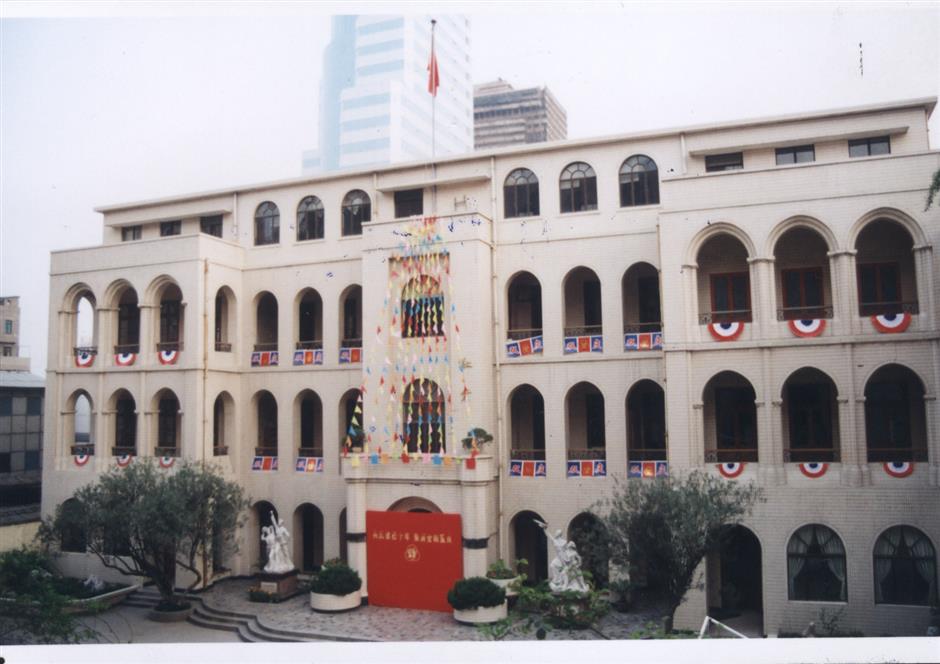
The old facade has been long covered by small white ceramic tiles.
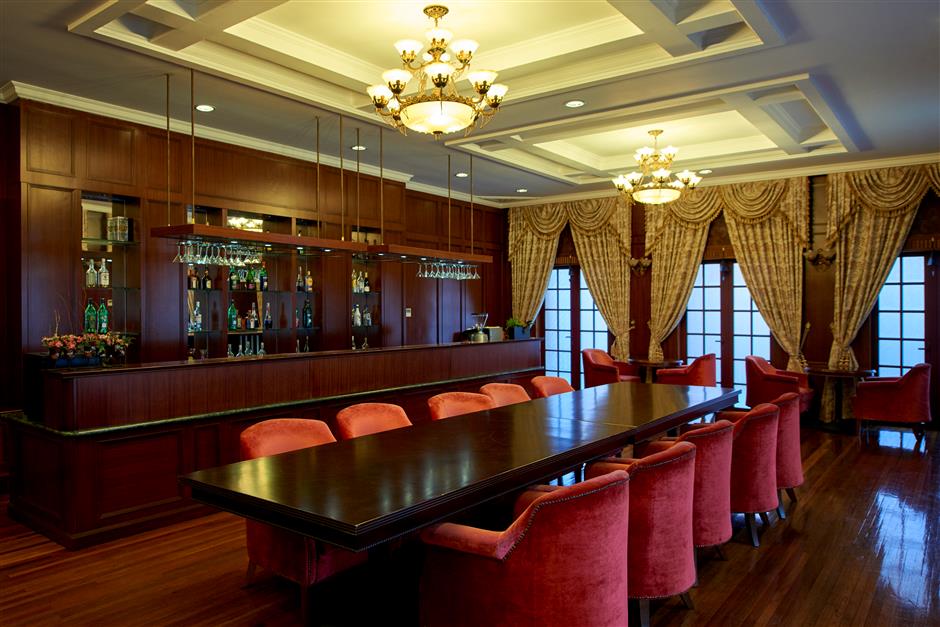
The upper floors of the building are now used by the Shanghai Business & Tourism School for conferences and students' activities.
Today, the 19th-century police station is a signature building of the school. The ground floor serves as a mini museum with a Shanghai commerce theme, which not only displays the building’s architectural history, but also showcases antique exhibits related to the city’s eventful commercial history. The upper floors are used for conferences and students’ social activities.
Opposite the building are the former cells and students enjoying coffee-making classes just a few steps away. Their self-designed products from cups to notebooks are on display. In addition to tourism and commerce, the school also has a heritage protection major.
“We will host concerts in this heritage building. We also have a plan to let students to do historical research and design introducing boards of this building’s history. Through this way, the value of this unique heritage can be passed on to the younger generation,” principal Li says.
About the building
Yesterday: Louza Police Station
Today: Shanghai Business & Tourism School
Architect: Arthur Dallas
Architectural style: Venetian Gothic style
Address: 101 Guizhou Rd
Tips: The building is not open to the public but the facade can be admired from the school gate.

Pipers' stirring invitation
The new and magnificent Louza Police Station, behind the Racquet Court, was opened on Saturday evening with a dinner followed by speeches and songs, given by the European members of the municipal police under the presidency of the captain Superintendent, Mr J. P. McEuen, R.N.
In the large upper room on the third floor, which is intended to be used as a dormitory for the European constables, and which was decorated with flags and evergreens, two long tables were laid out with a cross table at one end, and here soon after eight more than a hundred and thirty convives assembled, preceded up the winding stairs by the piper, playing a stirring invitation to the banquet.
Captain McEuen was in the chair, and he was supported by Mr Carles, British Vice-Consul, the Mixed Court Magistrate, several members of the Municipal Council, etc. Chief Inspector Cameron, supported by Mr Emens, US Vice-Consul-General, was at the end of one of the long tables and Inspector Kluth of the other.
All the learned professions, the arts and sciences, the royal navy, the volunteers and the mercantile marine, and of course commerce were represented in the company.
The dinner, which was provided by the Astor House, was solid and substantial, the beer and porter as well as the wines were beyond questions, and notwithstanding the large attendance and the gas, the ventilation was so admirable that there were no complaints of the heat, and it was never impossible to see through the clouds of smoke.
The pipers marched up and down the verandah during dinner, enlivening the entertainment with their weird harmonies, and if some of the speeches might have been abbreviated without disadvantage, there were no apparent signs of weariness in speakers or hearers.
Songs, much above the average of after-dinner melody, and a violin trio had been liberally interspersed among the speeches and it was nearly 1am when the last speaker sat down, and the company, well satisfied, went home through the fog.
— Excerpt from the North China Herald (January 3, 1890)
